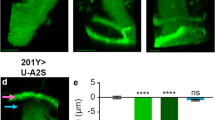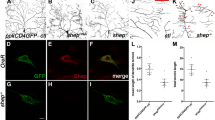Abstract
We have isolated and characterized the gene encoding a Drosophila melanogaster homolog of Caenorhabditis elegans UNC-51 (uncoordinated movement-51): Pegarn. Developmental Northern blot shows the Pegarn gene is expressed at all stages of development. The protein is detected throughout the Drosophila third instar larval central nervous system (CNS) in axons projecting out from the ventral ganglion and in the optic anlagen of the optic lobe. Heterozygous Pegarn mutant embryos show defects in larval axonal neuronal patterning, but survive to adulthood. Homozygous mutants have an even more deformed pattern of neuronal development and do not survive through the larval stages. The data from this research suggest the critical roles of Pegarn in CNS and PNS axonal formation in Drosophila melanogaster and indicates its similar role in other multicellular species.







Similar content being viewed by others
References
Hunter T (2000) Signaling—2000 and beyond. Cell 100:113–127. doi:10.1016/S0092-8674(00)81688-8
Nikolic M, Dudek H, Kwon YT et al (1996) The cdk5/p35 kinases is essential for neurite outgrowth during neuronal differentiation. Genes Dev 10:816–825. doi:10.1101/gad.10.7.816
Ohshima T, Ward JM, Huh CG et al (1996) Targeted disruption of the cyclin-dependent kinase gene results in abnormal corticogenesis, neuronal pathology and perinatal death. Proc Natl Acad Sci USA 93:111173–111178. doi:10.1073/pnas.93.20.11173
Arber S, Barbayannis FA, Hanser H et al (1998) Regulation of actin dynamics through phosphorylation of cofilin by LIM- kinase. Nature 393:805–809. doi:10.1038/31729
McIntire SL, Garriga G, White J (1992) Genes necessary for directed axonal elongation or fasciculation in C. elegans. Neuron 8:307–322. doi:10.1016/0896-6273(92)90297-Q
Brenner S (1974) The genetics of Caenorhabitis elegans. Genetics 77:71–94
Hedgecock EM, Culotti JG, Thomson JN (1985) Axonal guidance mutants of Caenorhabitis elegans identified by filling sensory neurons with fluorescein dyes. Dev Biol 111:158–170. doi:10.1016/0012-1606(85)90443-9
Toth ML, Simon P, Kovacs AL et al (2007) Influence of autophagy genes on ion-channel-dependent neuronal degeneration in Caenorhabditis elegans. J Cell Sci 120:1134–1141. doi:10.1242/jcs.03401
Oruga K, Wicky C, Magnenat L et al (1994) Caenorhabitis elegans UNC-51 gene required for axonal elongation encodes a novel serine/threonine kinases. Genes Dev 8:2389–2400. doi:10.1101/gad.8.20.2389
Kuroyanagi H, Yan J, Seki N et al (1998) Human ULK-1, a novel serine/threonine kinase related to UNC-51 kinase of Caenorhabitis elegans: cDNA cloning, expression, and chromosome assignment. Genomics 51:76–85. doi:10.1006/geno.1998.5340
Okazaki N, Yan J, Yuasa S et al (2000) Interaction of the UNC-51-like kinase and microtubule-associated protein light chain 3 related proteins in the brain: possible role of vesicular transport in axonal elongation. Brain Res Mol Brain Res 85:1–12. doi:10.1016/S0169-328X(00)00218-7
Tomada T, Bhatt RS, Kuroyanagi H et al (1999) A mouse serine/threonine kinase homologous to C. elegans UNC-51 functions in parallel fiber formation of cerebellar granule neurons. Neuron 24:833–846. doi:10.1016/S0896-6273(00)81031-4
Yan J, Kuroyanagi H, Tomemori T et al (1999) Mouse ULK2, a novel member of the UNC-51-like protein kinases: unique features of functional domains. Oncogene 18:5850–5859. doi:10.1038/sj.onc.1202988
Avery AW, Figueroa C, Vojtek AB (2007) UNC-51-like kinase regulation of fibroblast growth factor receptor substrate 2/3. Cell Signal 19:177–184. doi:10.1016/j.cellsig.2006.06.003
Zhou X, Babu JR, da Silva S et al (2007) Unc-51-like kinase 1/2-mediated endocytic processes regulate filopodia extension and branching of sensory axons. Proc Natl Acad Sci USA 104:5842–5847. doi:10.1073/pnas.0701402104
Hanks SK (1987) Homology probing: identification of cDNA clones encoding members of the protein-serine kinase family. Proc Natl Acad Sci USA 84:388–392. doi:10.1073/pnas.84.2.388
Hanks SK, Quinn AN, Hunter T (1988) The protein kinase family: conserved feature and deduced phylogeny of the catalytics domain. Science 241:42–52. doi:10.1126/science.3291115
Hanks SK (1991) Eukaryotic protein kinase. Curr Opin Struct Biol 1:369–383. doi:10.1016/0959-440X(91)90035-R
Cassill JA, Whitney M, Joazeiro CA (1991) Isolation of Drosophila genes encoding G protein-coupled receptor kinases. Proc Natl Acad Sci USA 88:11067–11070. doi:10.1073/pnas.88.24.11067
Feinberg AP, Vogelstein B (1983) A technique for radiolabeling DNA restriction endonuclease fragments to high specific activity. Anal Biochem 132:6–13. doi:10.1016/0003-2697(83)90418-9
Adams MD, Celniker SE, Gibbs RA (2000) The genome sequence of Drosophila melanogaster. Science 287:2185–2195. doi:10.1126/science.287.5461.2185
Rorth PR (1996) A modular misexpression screen in Drosophila detecting tissue-specific phenotypes. Proc Natl Acad Sci USA 93:12418–12422. doi:10.1073/pnas.93.22.12418
Hazelrigg T (1998) The uses of green fluorescent protein in Drosophila tissues. In: Chalfie M, Kain S (eds) GFP, green fluorescent protein: properties, applications and protocols. Wiley-Liss, New York, pp 169–190
Klambt C, Jacobs JR, Goodman CS (1991) The midline of Drosophila central nervous system: a model for the genetic analysis of cell fate, cell migration and growth cone guidance. Cell 64:801–815. doi:10.1016/0092-8674(91)90509-W
Kidd T, Russell C, Goodman CS (1998) Dosage-sensitive and complementary functions of roundabout and commissureless control axon crossing of the CNS midline. Neuron 1:25–33. doi:10.1016/S0896-6273(00)80431-6
Harris R, Sabatelli LM, Seeger MA (1996) Guidance cues at the Drosophila CNS midline: identification and characterization of two Drosophila Netrin/UNC-6 homologs. Neuron 17:217–228. doi:10.1016/S0896-6273(00)80154-3
Mitchell KJ, Doyle JL, Serafini T (1996) Genetic analysis of Netrin genes in Drosophila: Netrins guide CNS commissural axons and peripheral motor axons. Neuron 2:203–215. doi:10.1016/S0896-6273(00)80153-1
Oruga K, Goshima Y (2006) The autophagy-related kinase UNC-51 and its binding partner UNC-14 regulate the subcellular localization of the Netrin receptor UNC-5 in Caenorhabditis elegans. Development 133:3441–3450. doi:10.1242/dev.02503
Flanagan JG, van Vactor DV (1998) Through the looking glass: axon guidance at the midline choice point. Cell 92:429–432. doi:10.1016/S0092-8674(00)80935-6
Kidd T, Brose K, Mitchell KJ, Fetter RD, Tessier-Lavigne M, Goodman CS et al (1998) Roundabout controls axon crossing of the CNS midline and defines a novel subfamily of evolutionarily conserved guidance receptors. Cell 92:205–215. doi:10.1016/S0092-8674(00)80915-0
Mitchell KJ, Doyle JL, Serafini T, Kennedy TE, Tessier-Lavigne M, Goodman CS et al (1996) Genetic analysis of Netrin genes in Drosophila: Netrins guide CNS commissural axons and peripheral motor axons. Neuron 17:203–215. doi:10.1016/S0896-6273(00)80153-1
Acknowledgments
The monoclonal antibodies, 22C10 and BP102, developed by Corey Goodman and Seymour Benzer, were obtained from the Developmental Studies Hybridoma Bank developed under the auspices of the NICHD and maintained by the University of Iowa, Department of Biological Sciences, Iowa City, IA 52242. EP fly lines were obtained from the Bloomington Drosophila Stock Center at Indiana University. This work was supported by NIH MBRS grant GM008194. I.B. Terrazas, C.T. Garcia, and J.J. Narzarian were supported by the MBRS program. NIH GM 60655.
Author information
Authors and Affiliations
Corresponding author
Rights and permissions
About this article
Cite this article
Ahantarig, A., Chadwell, L.V., Terrazas, I.B. et al. Molecular characterization of Pegarn: a Drosophila homolog of UNC-51 kinase. Mol Biol Rep 36, 1311–1321 (2009). https://doi.org/10.1007/s11033-008-9314-4
Received:
Accepted:
Published:
Issue Date:
DOI: https://doi.org/10.1007/s11033-008-9314-4




